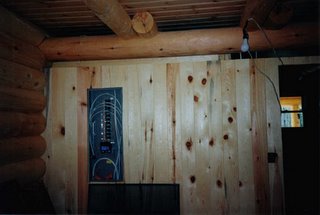 The 200 amp service panel was placed within an interior partition of the bedroom. From the service panel the wiring was fed vertically from the crawl space into the interior partitions and thru pre-drilled vertical holes in the exterior logs to switches, outlets and the main ceiling.
The 200 amp service panel was placed within an interior partition of the bedroom. From the service panel the wiring was fed vertically from the crawl space into the interior partitions and thru pre-drilled vertical holes in the exterior logs to switches, outlets and the main ceiling.The wiring of the interior lights was placed below the loft and are hidden by a grooved flat board nailed to the bottom of the wood deck of the loft floor.
 GFCI outlets were placed in the vanity space and around the kitchen area.
GFCI outlets were placed in the vanity space and around the kitchen area.These outlets are per the electrical code and were used where it is possible to over-load the capacity of the wiring. The outlet automatically shuts off the power. After the shut off the outlet can be manually reset to work again.
In the kitchen area the GFCI outlets were wired in line with only one outlet that had a manual reset. Several outlets down line from the manual reset outlet lost power. We tested the outlets; but no power. We thought the wiring had gone bad, until the up line reset outlet was pushed. Wow - the outlets worked again.
The electric stove, the submergeable water pump, the hot water heater and the base board heaters were wired with a 220 volt service.
An electric heater was installed in the crawl space near the pressure tank and the hot water heater to provide heat to the crawl space during the colder weather.
 A trouble light and outlet was placed in the crawl space near the presure tank and hot water heater. The light came to our aid providing illumination when I replaced the burned out electric electrodes in the hot water heater.
A trouble light and outlet was placed in the crawl space near the presure tank and hot water heater. The light came to our aid providing illumination when I replaced the burned out electric electrodes in the hot water heater.An exterior waterproof outlet was placed on the porch for electrical accessories. It came in handy for an electric cord hook- up to a head bolt heater in our car during a cold weather spell.
No comments:
Post a Comment